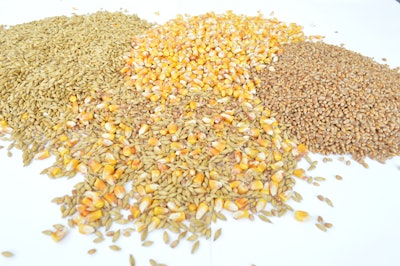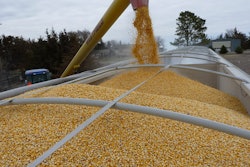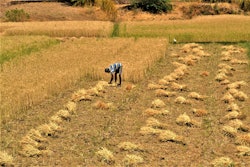
The International Grains Council (IGC) released its latest forecast on April 29.
Mainly because of an increase for maize, the forecast for world total grains (wheat and coarse grains) production in 2020/21 is 2m t higher m/m (month-on-month), to 2,226m, up 2% y/y (year-on-year).
The supply boost is absorbed by greater use, including higher feeding of wheat and larger industrial usage of maize, leaving projected stocks broadly unchanged m/m. As an upgrade for barley is outweighed by cuts for wheat and maize, the figure for global trade is fractionally lower m/m. The outlook for total grains supply and demand in 2021/22 is barely changed m/m.
Largely tied to an upgrade for Brazil, the forecast for 2020/21 soyabean production is increased by 1m t m/m, to 362m, up by 7% y/y. With the outlook for consumption broadly steady, inventories are raised to 47m t (-5m y/y).
Trade is lifted slightly to a peak of 171m t (+1m). The projection for 2021/22 global output is maintained at a record of 383m t but, due to larger opening stocks, supplies are placed marginally higher m/m. The supply increase is absorbed by uprated consumption, leaving stocks unchanged m/m, at 50m t (+3m). Trade is projected at 173m t (+2m).
Due to a fractional upward revision to consumption, the forecast for world rice stocks in 2020/21 is trimmed by 1m t, to 173m, marginally lower y/y. Reflecting a smaller figure for carry-ins and a reduced production outlook, 2021/22 global availabilities are trimmed m/m, resulting in a 1m t cut to carryovers, to 176m (+3m y/y); within the total, exporters’ stocks are lowered to 40m (+2m y/y). Trade in 2022 is predicted steady y/y, at 46m t.
With strong gains for all the components other than rice, the IGC Grains and Oilseeds Index (GOI) rose by 8% m/m, to its highest since mid-2013.
OVERVIEW
An increase in global total grains (wheat and coarse grains) supply in 2020/21 of 36m t is expected to be outweighed by a 44m rise in consumption, leaving stocks 8m smaller y/y, at a five-year low of 609m. The drop in stocks is mainly because of another drawdown for maize, to the least in eight years, which contrasts with a build-up for wheat to a record. Trade is seen reaching a new high of 416m t (+21m y/y).
Led by increases for wheat (+16m t) and maize (+52m), only partly offset by decreases for barley, oats and rye, world total grains production in 2021/22 is projected to climb by 61m, to a record 2,287m. With the net increase in supply (+52m t), matched by the rise in use, world stocks are expected to stay at 609m at the end of 2021/22.
However, inventories of maize are expected to fall again, to a nine-year low, while further accumulation is foreseen for wheat. Total grains trade is projected to be the second highest ever, at 409m t.
Underpinned by bigger crops in the US and Brazil, global soyabean output in 2020/21 is forecast 7% higher y/y. Nevertheless, with an expected solid increase in consumption, stocks are seen falling for the second consecutive season, including US carryovers contracting by 80% y/y.
After surging in the previous year, global trade is seen increasing only marginally, albeit to a new peak. With high prices expected to elicit a supply response, 2021/22 world output is tentatively placed at a record of 383m t (+6% y/y). Consumption is expected to climb further, while modest inventory accumulation is likely. World import demand is projected at a fresh high.
Reflecting larger crops in Asia, world rice production in 2020/21 is estimated at a new high, with record utilisation resulting in a marginal tightening of inventories. Global output in 2021/22 is projected to increase by 1% to a new peak, including larger outturns in India and China. Population growth should lift food use in Asia, taking consumption to a fresh high, with carryovers predicted at a peak of 176m t. Trade is projected at 46m t in 2022, little-changed y/y, with firm demand from buyers in Africa again likely to be a central feature.
Read the full report here.

















